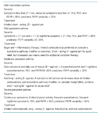Abstract
Respiratory illness is an important cause of morbidity and mortality in the elderly. For example, chronic obstructive pulmonary disease (COPD) is the 4th leading cause of death and the only disease among the top five that continues to increase in its prevalence. There are several changes in the respiratory system in the elderly compared with in the young, which include decreased immune defense, anatomic changes such as decreased elastic recoil and increased compliance, changes in the pulmonary function such as decreased vital capacity, increased closing volume, and decreased function of respiratory muscles, and changes in the gas exchange such as ventilation-perfusion mismatch and reduced diffusion capacity. In the elderly, coexisting morbidities such as coronary heart disease, liver, renal disease, neuropsychiatric diseases are more prevalent, and adverse drug reactions due to altered drug metabolism, elimination, and drug interaction are more common. In this article, clinical presentation, diagnosis, treatment, and prognosis of three most common respiratory illnesses in the elderly, pneumonia, bronchial asthma, and COPD, are discussed.
Figures and Tables
References
2. National Vital Statics Report. 2001. 49:1–49.
3. Bartlett JG, Dowell SF, Mandell LA, File TM Jr, Musher DM, Fine MJ. Practice guidelines for the management of community-acquired pneumonia in adults. Clin Infect Dis. 2000. 31:347–382.

4. Niederman MS, Mandell LA, Anzueto A, Bass JB, Broughton WA, Yu VL, et al. Guidelines for the management of adults with community-acquired pneumonia: diagnosis, assessment of severity, antimicrobial therapy, and prevention. Am J Respir Crit Care Med. 2001. 63:1730–1754.
5. Hospital-acquired pneumonia in adults: diagnosis, assessment of severity, initial antimicrobial therapy, and preventive strategies. Am J Respir Crit Care Med. 1996. 153:1711–1712.
6. Hill NK, Sanders CV. Anaerobic disease of the lung. Infect Dis Clin North Am. 1991. 5(3):453–456.

7. Bartlett JG. Anaerobic bacterial infections in the lung. Chest. 1987. 91:901–909.
9. Ruiz M, Ewig S, Marcos M, Martinez JA, Arancibia F, Torres A, et al. Etiology of community-acquired pneumonia: impact of age, comorbidity, and severity. Am J Respir Crit Care Med. 1999. 160:397–405.
10. Koivula I, Sten M, Makela PH. Risk factors for pneumonia in the elderly. Am J Med. 1994. 96:313–320.

11. Metlay JP, Schulz R, Li YH, Singer DE, Marrie TJ, Fine MJ, et al. Influence of age on symptoms at presentation in patient with community-acquired pneumonia. Arch Intern Med. 1997. 157:1453–1459.

12. Murphy TF, Fine BC. Bacteremic pneumococal pneumonia in elderly. Am J Med Sci. 1984. 288:114–118.
13. Fine MJ, Auble TE, Yealy DM, Hanusa BH, Weissfeld LA, Kapoor WN, et al. A aprediction rule to identify low-risk patients with community-acquired pneumonia. N Engl J Med. 1997. 336:243–250.

14. Meehan TP, Fine MJ, Krumholz HM, Scinto JD, Galusha DH, Fine MJ, et al. Quality of care, process, and outcomes in elderly patients with pneumonia. JAMA. 1997. 278:2080–2084.

15. Fine MJ, Smith MA, Carson CA, Mutha SS, Sankey SS, Kapoor WN, et al. Prognosis and outcomes of patients with community-acquired pneumonia. A meta-analysis. JAMA. 1996. 275:134–141.

16. Gross PA, Hermogenes AW, Sacks HS, Lau J, Levandowski RA. The efficacy of influenza vaccine in elderly persons. A meta-analysis and review of the literature. Ann Intern Med. 1995. 123:518–527.

17. Bauer BA, Reed CE, Youginger JW, Wollan PC, Siverstein MD. Incidence and outcomes of asthma in the elderly. A population based study in Rochester, Minnesota. Chest. 1997. 111:303–301.
18. Evans R 3rd, Mullally DI, Wilson RW, Gergen PJ, Rosenberg HM, Feinleib M, et al. National trends in the morbidity and mortality of asthma in the US. Prevalence, hospitalization and death from asthma over two decades: 1965-1984. Chest. 1987. 91:6 Suppl. 65S–74S.

19. Bardana EJ Jr. Is asthma really differnet in the elderly patient? J Asthma. 1993. 30:77–79.
20. Klink M, Cline MG, Halonen M, Burrows B. Problems in defining normal limits for serum IgE. J allergy Clin Immunol. 1990. 85:440–444.

22. Global Initiative for Asthma(GINA). Global strategy for asthma management and prevention: NHLBI/WHO Workshop Report. 2002. 02. Bethesda: National Institutes of Health, National Heart, Lung and Blood Institute;3659.
23. Burr ML, Charles TJ, Roy K, Seaton A. Asthma in elderly: an epidemiologic survey. BMJ. 1979. 1:1041–1049.
24. Robertson CF, Rubinfeld AR, Bow G. Deaths from asthma in Victoria: a 12-month survey. Med J Aust. 1990. 152:511–517.

26. Sin DD, McAlister FA, Paul Man SF, Anthonisen NR. Contemporary management of chronic obstructive pulmonary disease. JAMA. 2003. 290:2301–2312.

27. Pauweis RA, Buist AS, Calverley PM, Jenkins CR, Hurd SS. Global Strategy for the Diagnosis, Management, and Prevention of Chronic Obstructive Pulmonary Disease. NHLBI/WHO Global Initiative for Chronic Obstructive Lung Disease(GOLD) Workshop Summary. Am J Respir Crit Care Med. 2001. 163:1256–1276.





 PDF
PDF ePub
ePub Citation
Citation Print
Print








 XML Download
XML Download